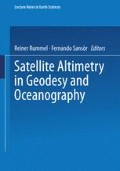Abstract
The United Kingdom Fine Resolution Antarctic Model is compared to 3 years of Geosat altimeter data. To enable a proper comparison two analysis techniques (Fourier and principal component analysis) are applied to both model results and the “real ocean” altimeter observations. In general it was found that the model succeeded in simulating important characteristics of the southern ocean. The analysis results from the very complex altimeter observations were verified, and the interpretation of Geosat data was strongly improved. The applied analysis techniques where shown to be effective in isolating ring-like phenomena and detecting possible periodic behaviour. In both the Agulhas, Brazil Malvinas, and East Australian Current regular ring formations take place, roughly every 100, 150, and 130 days respectively. The model only generated periodic ring formations in the Agulhas and East Australian Current, both with a very regular 125–130 days period. This period is clearly a model favored harmonic (1/3 year) which is however surprisingly close to the observations.
Preview
Unable to display preview. Download preview PDF.
References
Bretherton, F.P., R.E. Davis, and C.B. Fandry, A technique for objective analysis and design of oceanographic experiments applied to MODE-73, Deep Sea Res., 23, 559–582, 1976.
Chelton, D.B., M.G. Schlax, D.L. Witter, and J.D. Richman, Geosat altimeter observations of the surface circulation of the Southern Ocean, J. Geophys. Res., 95, (C10), 17,877–17,903, 1990.
Cheney R.E., J.G. Marsh, and B.D. Beckley, Global mesoscale variability from collinear tracks of SEASAT altimeter data, J. Geophys. Res., 88, (C7), 4343–4354, 1983.
Cheney, R.E., B.C. Douglas, R.W. Agreen, L. Miller, D.L. Porter, and N.S. Doyle, Geosat altimeter geophysical data record user handbook, NOAA Techn. Memo. NOS NGS-46, Natl. Oceanic and Atmos. Admin. Rockville, Md., 1987.
Cox, M.D., A primitive equation, 3-dimensional model of the ocean, GFDL, Ocean Gr. Tech. Rep., 1, 1984.
De Ruijter, W.P.M., Asymptotic analysis of the Agulhas and Brazil Current Systems, J. Phys. Oceanogr., 12, 361–373, 1982.
Dewar W., Ventilating warm rings: Theory and energetics, J. Phys. Oceanogr., 17, 2219–2231, 1987.
Feron, R.C.V., W.P.M. De Ruijter, and D. Oskam, Ring-shedding in the Agulhas Current System, J. Geophys. Res., 97, 9467–9477, 1992.
Feron, R.C.V., M.C. Naeije, and D. Oskam, Quality estimates for ocean variability results from satellite altimetry, Mar. Geodesy, 15, 1–18, 1991.
Garzoli, S.L., and Z. Garraffo, Transports, frontal motions and eddies at the Brazil-Malvinas Currents Confluence, Deep Sea Res., 36, 681–703, 1989.
Gordon, A.L., Interocean exchange of thermocline water, J. Geophys. Res., 91 (C4), 5037–5046, 1986.
Gordon, A.L., J.R.E. Lutjeharms, and M.L. Gründlingh, Stratification and circulation at the Agulhas Retroflection, Deep Sea Res., 34, 565–599, 1987.
Gordon, A.L., and W.F. Haxby, Agulhas eddies invade the South Atlantic-Evidence from Geosat altimeter and shipboard CTD, J. Geophys. Res., 95, (C3), 3117–3125, 1990.
Gordon, A.L., R.F. Weiss, W.M. Smethie, Jr., and M.J. Warner, Thermocline and intermediate water communication between the South Atlantic and Indian Oceans, J. Geophys. Res., 97, (C5), 7223–7240, 1992.
Hellerman, S., and M. Rosenstein, Normal monthly wind stress over the world ocean with error estimates, J. Phys. Oceanogr., 13, 1093–1104, 1983.
Kelly, K., Comment on “Empirical orthogonal function analysis of advanced very high resolution radiometer surface temperature patterns in Santa Barbara Channel” by G.S.E. Lagerloef and R.L. Bernstein, J. Geophys. Res., 93 15,753–15,754, 1988.
Legeckis, R., and A.L. Gordon, Satellite observations of the Brazil and Falklands currents-1975 to 1976 and 1978, Deep Sea Res., 29, 275–401, 1982.
Levitus, S., Climatological atlas of the world ocean, NOAA, Prof. Pap., 13 U.S. Dept. of Commerce, 173 pp, 1982.
Lutjeharms J.R.E., Meridional heat transport across the Sub-tropical Convergence by a warm eddy, Nature, 331, 251–254, 1988.
Lutjeharms, J.R.E., and R.C. van Ballegooyen, The retroflection of the Agulhas Current, J. Phys. Oceanogr., 18, 1570–1583, 1988.
Milbert, D., B. Douglas, R. Cheney, L. Miller, and R. Agreen, Calculation of Sea Level Time Series from non-collinear Geosat altimeter data, Mar. Geod., 12, 287–302, 1988.
Moritz, H., Advanced Physical Geodesy, Herbert Wichman Verlag, Karlsruhe, Germany, 1980.
Mulhearn, P.J., The Tasman front: a study using satellite infrared imagery, J. Phys. Oceanogr., 17, 1148–1155, 1987.
Nilsson, C.S., and G.R. Cresswell, The formation and evolution of East Australian Current warm-core eddies, Prog. Oceanogr., 9, 133–183, 1981.
Park, Y-H., Evidence of semiannual baroclinic Rossby waves south of the Indian Ocean from satellite altimetry, C.R. Acad. Sci. Paris, 310, Ser. II, 919–926, 1990.
Parke M.E., R.H. Steward, D.L. Farless, and D.E. Cartwright, On the choice of orbits for an altimeter satellite to study ocean circulation and tides, J. Geophys. Res., 92, (C11), 11693–11707, 1987.
Preisendorfer R.W. (1988) Principal Component Analysis in Meteorology and Oceanography, Developments in Atmospheric Science 17, Elsevier, 1988.
Rintoul, S.R. South Atlantic interbasin exchange, J. Geophys. Res., 96, (C2), 2675–2692, 1991.
Roden, G. I., Thermohaline fronts and baroclinic flow in the Argentine Basin during the austral spring of 1984, J. Geophys. Res. 91, 5075–5093, 1986.
Semtner, A. J., and R. M. Chervin, A simulation of the global ocean circulation with resolved eddies, J. Geophys. Res., 93, 15502–15522, 1988.
Stevens, D. P., On open boundary conditions for three-dimensional primitive equation ocean circulation models. Geophys. and Astrophys. Fluid Dyn., 51, 103–133, 1990.
Webb, D.J. et al. (The FRAM Group), An Eddy-resolving model of the Southern Ocean. EOS, Vol. 72, 15, 169, 174, 175, 1991.
Author information
Authors and Affiliations
Editor information
Rights and permissions
Copyright information
© 1993 Springer-Verlag
About this chapter
Cite this chapter
Feron, R.C.V. (1993). Comparing the UK Fine Resolution Antarctic Model (FRAM). In: Rummel, R., Sansò, F. (eds) Satellite Altimetry in Geodesy and Oceanography. Lecture Notes in Earth Sciences, vol 50. Springer, Berlin, Heidelberg. https://doi.org/10.1007/BFb0117936
Download citation
DOI: https://doi.org/10.1007/BFb0117936
Published:
Publisher Name: Springer, Berlin, Heidelberg
Print ISBN: 978-3-540-56818-6
Online ISBN: 978-3-540-47758-7
eBook Packages: Springer Book Archive

